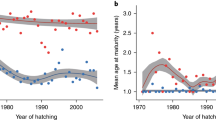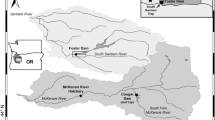Abstract
The development of Atlantic salmon (Salmo salar) parr was monitored during the first year in a fresh-water hatchery environment to test whether multilocus heterozygosity (computed for six allozyme loci: s AAT-4*, IDDH-1*, IDDH-2*, IDPH-3*, s MDH-3,4* andm MEP-2*) is associated with growth (body mass, fork length) and maturity status (mature male parr). The length frequency distribution of population was unimodal in September, but was clearly bimodal by December. UMG fish tended to be more heterozygous and had higher growth rates than LMG fish. The heterozygosity of UMG fish and mature male parr (MMP) did not differ significantly but MMP showed lower growth rates than UMG. There were positive correlations between the number of heterozygotic loci and the fork length, weight or growth rates of individuals.
Similar content being viewed by others

References
Berglund, J.K., Schmitz, M. and Lundqvist, H. 1992. Seawater adaptability in Baltic salmon (Salmo salar): A bimodal smoltification pattern in previously mature males. Can. J. Fish. Aquat. Sci. 49: 1097-1106.
Blanco, G., Sánchez, J.A., Vázquez, E., García, E. and Rubio, J. 1990. Superior developmental stability of heterozygotes at enzyme loci in Salmo salar. Aquaculture 84: 199-209.
Ferguson, M.M. 1990. Enzyme heterozygosity and growth of rainbow troutreared at two rations. Biol. J. Linn. Soc. 40: 215-227.
Glebe, B.D. and Saunders, R.L. 1986. Genetics factors in sexual maturity of cultured Atlantic salmon (Salmo salar) parr and adults reared in sea cages. In Salmonid Age at Maturity. pp. 24-29. Edited by D.J. Meerburg. Can. Spec. Publ. Fish. Aquat. Sci. 89.
Gross, M.R. 1984. Sunfish, salmon and the evolution of alternative reproductive strategies and tactics in fishes. In Fish Reproduction Strategies and Tactics. pp. 55-75. Edited by G.W. Potts and R.J. Wootton. Academic Press, London
Hutchings, J.A. and Myers, R.A. 1987. Escalation of an asymmetric contest: mortality resulting from male competition in Atlantic salmon. Can. J. Zool. 65: 776-768.
Jordan, W.C., Youngson, A.F. and Webb, J.H. 1990. Genetic variation at the malic enzyme-2 locus and age at maturity in sea-run Atlantic salmon (Salmo salar). Can. J. Fish. Aquat. Sci. 47: 1672-1677.
Jordan, W.C. and Youngson, A.F. 1991. Genetic protein variation and natural selection in Atlantic salmon (Salmo salar) parr. J. Fish Biol. 39: 185-192.
Leary, R.F., Allendorf, F.W. and Knudsen, K.L. 1983. Developmental stability and enzyme heterozygosity in rainbow trout. Nature, Lond. 301: 71-72.
Leary, R.F., Allendorf, F.W. and Knudsen, K.L. 1984. Superior developmental stability of heterozygotes at enzyme loci in salmonid fishes. Am. Nat. 124: 540-551.
Leary, R.F., Allendorf, F.W. and Knudsen, K.L. 1985. Developmental instability as an indicator of reduced genetic variation in hatchery trout. Trans. Am. Fish. Soc. 114: 230-235.
Lundqvist, H., Clarke, W.C., Eriksson, L.O., Funegard, P. and Engstrom, B. 1986. Seawater adaptability in three different river stocks of Baltic salmon during smolting. Aquaculture 52: 219-229.
Metcalfe, N.B., Huntingford, F.A., Graham, W.D. and Thorpe, J.E. 1989. Early social status and the development of life-history strategies in Atlantic salmon. Proc. Roy. Soc. Lond. 236: 7-19.
Mitton, J.B. and Grant, M.C. 1984. Association among protein heterozygosity, growth rate and developmental homeostasis. Ann. Rev. Ecol. Syst. 15: 479-499.
Mitton, J.B. and Koehn, R.K. 1985. Shell shape variation in the blue mussel and its association with enzyme heterozygosity. J. Exp. Mar. Biol. Ecol. 90: 73-80.
Nicieza, A.G., Braña, F. and Toledo, M.M. 1991. Development of length-bimodality and smolting in wild stocks of Atlantic salmon under different growth conditions. J. Fish Biol. 38: 509-523.
Rowe, D.K. and Thorpe, J.E. 1990. Differences in growth between maturing and non-maturing male Atlantic salmon, Salmo salar L., parr. J. Fish Biol. 36: 643-658.
Pollard, S.M., Danzmann, R.G. and Claytor, R.R. 1994. Association between the regulatory locus PGM-1r* and life-history types of juvenile Atlantic salmon (Salmo salar). Can. J. Fish. Aquat. Sci. 51: 1322-1329
Sánchez, J.A., Blanco, G., Vázquez, E., García, E. and Rubio, J. 1991. Allozyme variation in natural populations of Atlantic salmon in Asturias (northern Spain). Aquaculture 93: 291-298.
Sánchez, J.A., Blanco, G., and Vázquez, E. 1993. Genetic status of Atlantic salmon (Salmo salar) in Asturian rivers (Northern Spain). In Genetic Conservation of Salmonid Fishes. pp. 219-225. Edited by J. Cloud and G. Thorgaard. Plenum Press, New York.
Saunders, R.L., Henderson, E.B., and Glebe, B.D. 1982. Precocious sexual maturation and smoltification in male Atlantic salmon. Aquaculture 28: 211-229.
Sokal, R.R. and Rohlf, F.J. 1981. Biometry. W.H. Freeman and Co., San Francisco.
Thorpe, J.E. 1975. Early maturity in male Atlantic salmon. Scot. Fish Bull. 42: 15-17.
Thorpe, J.E. 1977. Bimodal distribution of length of Atlantic salmon under artificial rearing conditions. J. Fish Biol. 11: 175-184.
Thorpe, J.E. 1986. Age at first maturity in Atlantic salmon: freshwater period influences and conflicts with smolting. In Salmonid Age at Maturity. pp. 7-14. Edited by D.J. Meerburg. Can. Spec. Publ. Aquat. Sci. 89.
Thorpe, J.E. 1987. Smolting versus residency: developmental conflict in salmonids. Am. Fish. Soc. Symp. 1: 244-252.
Thorpe, J.E. and Morgan, R.I.G. 1980. Growth-rate and smoltingrate of progeny of Atlantic salmon parr, Salmo salar L. J. Fish Biol. 17: 451-459.
Thorpe, J.E., Talbot, C. and Villareal, C.A. 1982. Bimodality of growth and smolting in Atlantic salmon. Aquaculture 28: 123-132.
Torrissen, K.R. 1991. Genetic variation in growth rate of Atlantic salmon with different trypsin-like isozymes patterns. Aquaculture 93: 299-312
Zouros, E and Foltz, D.W. 1987. The use of allelic isozyme variation for the study of heterosis. In Isozymes: Current Topics in Biological and Medical Research. Vol. 13, pp. 1-59. Edited by M.C. Rattazi, J.G. Scandalios and G.S. Witt. Liss, New York.
Zouros, E. and Pogson, G.H. 1994. The present status of the relationship between heterozygosity and heterosis. In Genetics and Evolution of Aquatic Organisms. pp. 135-146. Edited by A.R. Beaumont. Chapman and Hall, London.
Rights and permissions
About this article
Cite this article
Blanco, G., Presa, P., Vázquez, E. et al. Allozyme heterozygosity and development in Atlantic salmon, Salmo salar. Fish Physiology and Biochemistry 19, 163–169 (1998). https://doi.org/10.1023/A:1007771417270
Issue Date:
DOI: https://doi.org/10.1023/A:1007771417270



